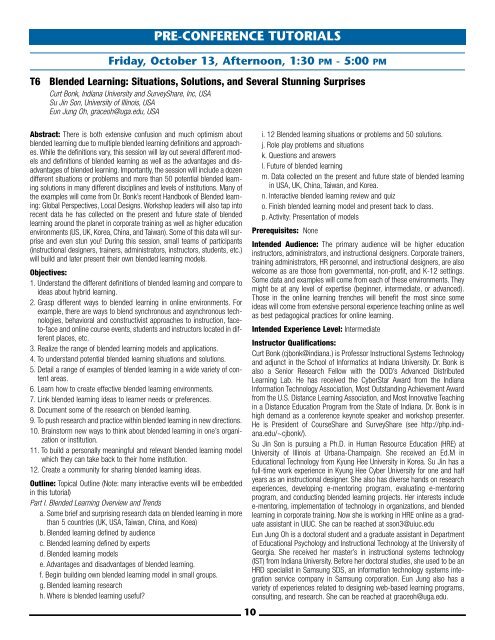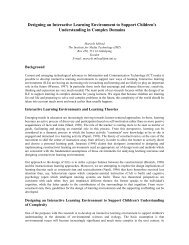October 13-17, 2006 Honolulu, Hawaii USA - Association for the ...
October 13-17, 2006 Honolulu, Hawaii USA - Association for the ...
October 13-17, 2006 Honolulu, Hawaii USA - Association for the ...
Create successful ePaper yourself
Turn your PDF publications into a flip-book with our unique Google optimized e-Paper software.
PRE-CONFERENCE TUTORIALSFriday, <strong>October</strong> <strong>13</strong>, Afternoon, 1:30 PM - 5:00 PMT6Blended Learning: Situations, Solutions, and Several Stunning SurprisesCurt Bonk, Indiana University and SurveyShare, Inc, <strong>USA</strong>Su Jin Son, University of Illinois, <strong>USA</strong>Eun Jung Oh, graceoh@uga.edu, <strong>USA</strong>Abstract: There is both extensive confusion and much optimism aboutblended learning due to multiple blended learning definitions and approaches.While <strong>the</strong> definitions vary, this session will lay out several different modelsand definitions of blended learning as well as <strong>the</strong> advantages and disadvantagesof blended learning. Importantly, <strong>the</strong> session will include a dozendifferent situations or problems and more than 50 potential blended learningsolutions in many different disciplines and levels of institutions. Many of<strong>the</strong> examples will come from Dr. Bonk’s recent Handbook of Blended learning:Global Perspectives, Local Designs. Workshop leaders will also tap intorecent data he has collected on <strong>the</strong> present and future state of blendedlearning around <strong>the</strong> planet in corporate training as well as higher educationenvironments (US, UK, Korea, China, and Taiwan). Some of this data will surpriseand even stun you! During this session, small teams of participants(instructional designers, trainers, administrators, instructors, students, etc.)will build and later present <strong>the</strong>ir own blended learning models.Objectives:1. Understand <strong>the</strong> different definitions of blended learning and compare toideas about hybrid learning.2. Grasp different ways to blended learning in online environments. Forexample, <strong>the</strong>re are ways to blend synchronous and asynchronous technologies,behavioral and constructivist approaches to instruction, faceto-faceand online course events, students and instructors located in differentplaces, etc.3. Realize <strong>the</strong> range of blended learning models and applications.4. To understand potential blended learning situations and solutions.5. Detail a range of examples of blended learning in a wide variety of contentareas.6. Learn how to create effective blended learning environments.7. Link blended learning ideas to learner needs or preferences.8. Document some of <strong>the</strong> research on blended learning.9. To push research and practice within blended learning in new directions.10. Brainstorm new ways to think about blended learning in one’s organizationor institution.11. To build a personally meaningful and relevant blended learning modelwhich <strong>the</strong>y can take back to <strong>the</strong>ir home institution.12. Create a community <strong>for</strong> sharing blended learning ideas.Outline: Topical Outline (Note: many interactive events will be embeddedin this tutorial)Part I. Blended Learning Overview and Trendsa. Some brief and surprising research data on blended learning in morethan 5 countries (UK, <strong>USA</strong>, Taiwan, China, and Koea)b. Blended learning defined by audiencec. Blended learning defined by expertsd. Blended learning modelse. Advantages and disadvantages of blended learning.f. Begin building own blended learning model in small groups.g. Blended learning researchh. Where is blended learning useful?i. 12 Blended learning situations or problems and 50 solutions.j. Role play problems and situationsk. Questions and answersl. Future of blended learningm. Data collected on <strong>the</strong> present and future state of blended learningin <strong>USA</strong>, UK, China, Taiwan, and Korea.n. Interactive blended learning review and quizo. Finish blended learning model and present back to class.p. Activity: Presentation of modelsPrerequisites: NoneIntended Audience: The primary audience will be higher educationinstructors, administrators, and instructional designers. Corporate trainers,training administrators, HR personnel, and instructional designers, are alsowelcome as are those from governmental, non-profit, and K-12 settings.Some data and examples will come from each of <strong>the</strong>se environments. Theymight be at any level of expertise (beginner, intermediate, or advanced).Those in <strong>the</strong> online learning trenches will benefit <strong>the</strong> most since someideas will come from extensive personal experience teaching online as wellas best pedagogical practices <strong>for</strong> online learning.Intended Experience Level: IntermediateInstructor Qualifications:Curt Bonk (cjbonk@indiana.) is Professor Instructional Systems Technologyand adjunct in <strong>the</strong> School of In<strong>for</strong>matics at Indiana University. Dr. Bonk isalso a Senior Research Fellow with <strong>the</strong> DOD’s Advanced DistributedLearning Lab. He has received <strong>the</strong> CyberStar Award from <strong>the</strong> IndianaIn<strong>for</strong>mation Technology <strong>Association</strong>, Most Outstanding Achievement Awardfrom <strong>the</strong> U.S. Distance Learning <strong>Association</strong>, and Most Innovative Teachingin a Distance Education Program from <strong>the</strong> State of Indiana. Dr. Bonk is inhigh demand as a conference keynote speaker and workshop presenter.He is President of CourseShare and SurveyShare (see http://php.indiana.edu/~cjbonk/).Su Jin Son is pursuing a Ph.D. in Human Resource Education (HRE) atUniversity of Illinois at Urbana-Champaign. She received an Ed.M inEducational Technology from Kyung Hee University in Korea. Su Jin has afull-time work experience in Kyung Hee Cyber University <strong>for</strong> one and halfyears as an instructional designer. She also has diverse hands on researchexperiences, developing e-mentoring program, evaluating e-mentoringprogram, and conducting blended learning projects. Her interests includee-mentoring, implementation of technology in organizations, and blendedlearning in corporate training. Now she is working in HRE online as a graduateassistant in UIUC. She can be reached at sson3@uiuc.eduEun Jung Oh is a doctoral student and a graduate assistant in Departmentof Educational Psychology and Instructional Technology at <strong>the</strong> University ofGeorgia. She received her master’s in instructional systems technology(IST) from Indiana University. Be<strong>for</strong>e her doctoral studies, she used to be anHRD specialist in Samsung SDS, an in<strong>for</strong>mation technology systems integrationservice company in Samsung corporation. Eun Jung also has avariety of experiences related to designing web-based learning programs,consulting, and research. She can be reached at graceoh@uga.edu.10
















